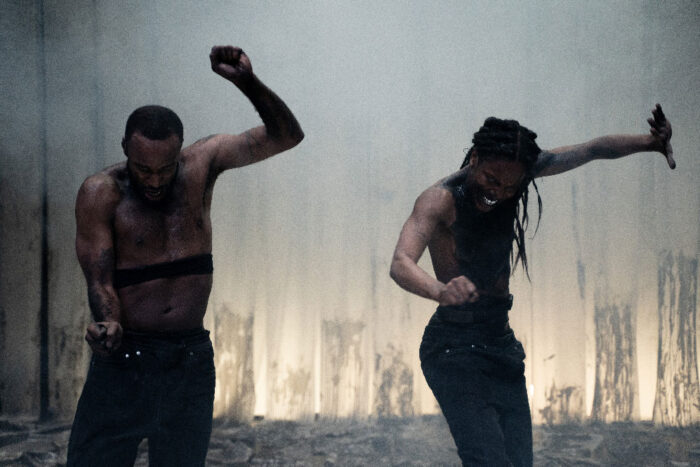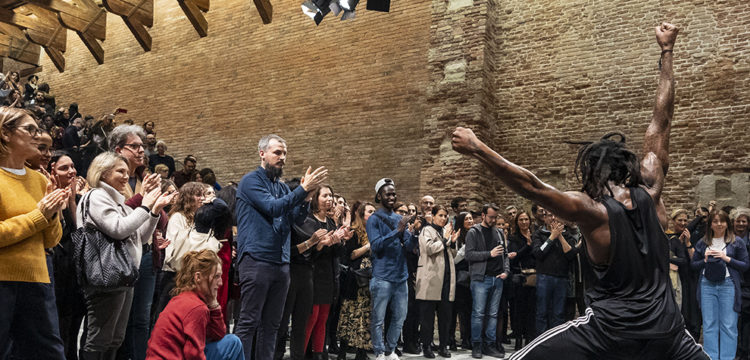On (DARK)MATTER
A strike through DARK. A conversation with Cherish Menzo
DARKMATTER is a laboratory of experiments in which Cherish Menzo, together with Camilo Mejía Cortés, reflects once again on the cultural implications of the black body and experiments with the multiple possibilities that its own fluid substance allow, to free ourselves of the distorted way of looking at bodies and the stereotyped signs that we attribute to them.
The black body is dark matter, unfathomable, almost invisible yet powerful. What happens when we watch it while disconnecting it from the stories and labels attributed to it? Stretching voices and movements, as in a Chopped and Screwed remix, perceptions are altered and the body reveals itself as malleable material.
Cherish Menzo will be at Short Theatre 2022 also on September 9th, in the frame of Anticipation of the Night, in a talk in dialogue with Francesca De Rosa (scholar of Cultures of Ibero-American Countries, Luso-african studies and professor at Università degli Studi di Napoli L’Orientale) and on September 11th, with the workshop Distorted Rap Choir/Chopped and Screwed.
Beside the usual partnership, this year NERO and Short unite in a new entity with the new Short Books publishing series, at the crossroads of aesthetics, critical thinking and performing arts’ practices. The first issue is Palcoscenici Fantasma: Gisèle Vienne by Bernard Vouilloux and translated by Edoardo Lazzari.
You can read the following conversation in Italian on CUT/ANALOGUE.
Roberta Da Soller: The first important issue in your recent work is the trilogy structure. You started this triptych with Jezebel, a very powerful performance about black video vixen bodies within the rap scene between the 90s and the 2000s. DARKMATTER continues this journey by adding fantastic matter on the possible autonarratives and self-definitions that Afrofuturism provides.
Both works are disruptive because, by narrating the devices by which the West and the patriarchal system make those bodies subaltern, they bring out not only the act of resistance but also another reality inscribed in the space of conflict.
Joan Morgan in her book When Chickenheads Come Home to Roost, written in 1999, referring to the rap scene of those years, states: “You are my key to the locker room. And while it’s true that your music holds some of fifteen- to thirty-year-old black men’s ugliest thoughts about me, it is the only place where I can challenge them.” It seems to me that your work goes in this direction, that is, that you establish a hand-to-hand with the space of conflict as an act of resistance, self-determination and agency. I would ask you to talk about the genesis of this trilogy and the relationship with rap music that returns in both works.
Cherish Menzo: The starting point of Jezebel was risen by what at that time seemed like a simple question: Where are the Video Vixens today? The women featured in the music video clips I watched and admired in my pre-teen and teenage years. Looking back, I realize that this question had a more profound and personal meaning to it and became part of finding my own agency in my self-determination.
During this period, my attention was drawn to movements like #MeToo and vivid discussions about social gender injustice. I felt that the “female” body and sexuality was (re)claiming space and tried to emancipate itself from power relations and body objectification. Simultaneously, I could feel that artists were strongly questioning the representation of the ”female” body, sexual stereotypes, and the romanticization of certain bodies perpetuated in the performing arts field by a heteronormative art history. Even though these portraits and questions triggered me, they also led to confusion and friction. There was a dissonance regarding the female references I grew up with and related to. I guess I felt that these portraits and questions may somewhat refer to the white or western female body and its narratives… Something urged me to revisit the origins of my perception and relation to the representation, value, beauty, contradictions, and intersections within and around the bodies of black women at first.
I realized that relating these questions around the female body and sexuality to black female bodies would have different connotations. I started to question archetypes of black female bodies echoed in hip-hop video clips from the late 90s and early 2000s: Video Vixens, hyper-sexualized women that were the product of male fantasy. A fantasy that some of today’s female rappers in pop and hip hop culture, like Cardi B, Megan Thee Stallion, and Saweetie, still keep alive. A hyper-sexuality that seems to have been reinstated but can also be seen as a reclamation of space and a stance on social gender injustice. Depending on who you ask… I was triggered by these collisions and contradictions and felt the need, somehow in this context, to investigate and create my own ecosystem and agency.
My interest grew more naturally from creating something that felt very close to me and that touched different layers of my experience, questions, conflicts (frictions), and aspirations in the performing arts. So, the next step was to figure out how to create and realize my own universe around that. I find the play with metaphors and double entendre within rap so ingenious and poetic. Due to rap being such an important linguistic tool and aspect in creating the visual imagination around the video vixens and a specific female narrative.
For Jezebel, I decided to explore and challenge this usage of words by writing lyrics and simultaneously playing with the formulas and structures used in rap songs. For DARKMATTER I wanted to continue to explore to use of rap as a performative tool.

R.D.S. I am very fascinated by cities, by the invisible of cities by what remains of an activity. Dealing with performance we are now trained to consider performativity as an elastic concept, which does not mean that everything is performative but that this concept inhabits different dimensions. It is more complicated to think of architecture and urban planning in an expansive way because, on one hand there is the risk of disciplinary purism that warns you against trespassing, and on the other of using architecture as a metaphor, i.e., as the reproduction of a figure we already know in order to make something else more comprehensible to us.
For some time now, I have been wondering whether it is possible to question the compositions that certain bodies give themselves with other bodies (human, non-human and non-animated). These bodies draw coordinates that cannot be traced by eye-sight, which in fact redesign inhabiting, staying, crossing. I wonder if it is possible to think of this activity, this modification of the real that constitutes the structure of human creation, as architecture.
I apologize for the length of this reflection, but it was born after seeing Jezebel last year at Short Theatre. In both Jezebel and DARKMATTER the city is looming, it is within the movement, it is in the movement. In Jezebel the performance springs from a lowrider bike and a road. In DARKMATTER, the city is the night, the quivering of what remains of the day, the invisible that manifests itself, the underside that set on fire. I would therefore ask you to spend some words on the relationship between bodies and the city as another subject of your research.
C.M. Thank you for sharing this rich and intriguing reflection. I love your remark that the cities of Jezebel and DARKMATTER are looming! I haven’t considered the spaces where Jezebel and DARKMATTER take place as urban cities yet, but more as fictional worlds where the boundaries, relationships, and purpose of the various (the bodies,—performance—space, the music, light, and scenography) or (Human, non-human, unanimated) inside these fictional worlds can shift. I got very inspired by Prof. Philip Butler and how he uses the term entity to decentralize the human.
Decentralizing the human created a ground where I could re-imagine the (human) body, its assigned architecture, and its interaction and relation to other entities. Perhaps in these fictional realms, some entities at times have parallel realities. After seeing DARKMATTER, performing artist, theater maker, and good friend of mine Khadija El Kharraz Alami recommended me to read Glitch Feminisme by Legacy Russel. I fell in love with this book and Legacy’s writing! A lot of what felt intuitive during the creation process of DARKMATTER fell into place after reading this book.
I am referring to Glitch Feminisme in relation to you mentioning that “there is the risk of using architecture as a metaphor, i.e., as the reproduction of a figure we already know in order to make something else more comprehensible to us.”
For both Jezebel and DARKMATTER (and probably for the third part) the distortion of the body and how we read the body has been my main drive. The idea of a figure or entity being pulled and or twisted out of its “original” shape creates a state and place of continuous transformation for me. A laboratory of reshaping, adding, subtracting, zooming in and out, bringing the exterior to the interior and the other way around, in search of the after or beyond, the unseen. To eventually be startled by your own Frankenstein monster… I guess to distort has been my way to Glitch, a tool to modify, become, contradict, error, and transcend.

R.D.S. Dark matter is a part of the cosmos that can only be detected indirectly, through its gravitational effects. However, such matter would seem to be indispensable for the universe not to collapse. The darkness with which your work DARKMATTER is sprayed, is actually a kind of tilted magnetic field where the black darkness shoots out in multiple directions, out of its assigned subjects. You could say it leaks out of sense; it loses its senses. And if we were to follow Deleuze, this spilling out would make room for disjunction. I think this point about the disassociation of darkness from a supposedly original matter is really an important aspect that I would like to ask you to focus on here.
C.M. In the performance title, I’ve put a strike through DARK. On the one hand, to delete or remove something, the error of its “negative” connotations. On the other hand, to bring emphasis to it, for us to gravitate to it. That darkness may exist, be considered for it to matter and be of importance. Darkness also becomes important in this work because the black body is placed “centre”. In that sense, darkness, the Abbys, the void, or DARKMATTER becomes a place for potential, speculation, and transformation a place that is maybe not always clear to understanding, blurry, and borderless. A place where the black body can become a fluid material that can freely dislocate itself from the “center”. (I hope I make sense hahah…)
R.D.S. Yes, it absolutely makes sense! There is a very valuable tool that theorist Josè Esteban Muñoz has given us, namely reflection around the word glimmer. When I think about your work, the word glimmer helps me to give some spacing to everything that I cannot focus on. A glimmer is a trace of memories trying to become embodied, the activity of glimmer reactivates the knowledge gathered in the bodily archives of such memories as a “utopian impulse”. It seems to me that both of the first two works in the trilogy are studded with fragments of a past that, pushes towards a future yet to be written.
We are well aware that every work of research and artistic practice produces something surplus that lies within the work and something pierces it, perforates it. Perhaps this question is projected into the next chapter but I am very interested to know more about the futurity in your artistic work, what other directions is it leading you in?
C.M. Ohh, hard question… It’s funny that already during my Bachelor in dance, whenever I was given the space to create something, the notion of time would be something I would always wonder about. I always had the desire to create something that felt infinite and often reserved in its chronology. (I guess that’s where the time distortion comes from, hahah).
So, for sure, there is the desire to create a third work that somehow relates itself to Jezebel and DARKMATTER, even tough, it will be written and hopefully presented in the future, I wonder if the chronologic order both inside the third work but also within the trilogy is something that I can play with? As a part of the research for DARKMATTER I touched a bit upon the surfaces of the Afro-Surinamese spirituality and spiritual science called Winti. I am eager to dive deeper into it and see how its relation to the cosmology. Perhaps this might be the glimmer…
So far, I have always performed in my own work, and I am very curious to see what it would bring for me to not perform in the next piece and collaborate with another black artist that will perform.

R.D.S. A final question that holds the research on movement and stage form together. There is an out-of-time that accompanies the entire composition on several levels. We were talking earlier about a kind of tilted magnetic field, but I mistakenly used the expression ‘shoots out’ because this out-of-time is instead given by a dilation of the elements and scene relationships.
You use for instance the compositional process of Chopped and Screwed, coming from 90s hip-hop music, and a number of other techniques that allowed you to saturate the scene. Could you tell us about this technique work in relation to the idea of breaking up natural time? What possibilities does out-of-time offer for the overturning of narratives? What is involved in choosing the progressive collapse of the matter time instead of a process of acceleration? What were the techniques that allowed you to work on this, besides Chopped and Screwed technique?
C.M. Chopped and Screwed is a technique of remixing originally used in hip-hop music. The technique was developed in the Houston hip-hop scene in the early 1990s by Robert Earl Davis JR. a.k.a DJ Screw.
The screwed technique is accomplished by drastically slowing the tempo and applying techniques such as skipping beats, record scratching, stop-time, repetition, and affecting portions of the original composition to create a “chopped-up” “oozing” version of the song.
To apply this technique, which is originally used in music and lyrics, I explore ways to bring time distortion and over articulation to the body and research how the relationship between the mouth, voice, sound, muscles, tissues can reinform and redefine the performing body and can propose new narrations, spaces, and body-forms. In addition to the Chopped and Screwed, Camilo and I looked for other ways to challenge and condition the body in the quest to explore various readings of it.
Such as reversing the process of an action. For example, for some of the text deliverance instead of directing it forward and something that has to become audible for the exterior, we explored what it would give if the action of delivering a text would be something that travels or strongly gravitates backwards/inside, filling up the interior spaces of the body and the space behind the body. Almost like the mouth being a Black hole sucking and stretching the material outside of its event horizon towards the inside.
Also, we challenge the body and the space by looking for ways to exhaust and surpass their physical limits and boundaries. This has actually provoked acceleration in time and movement. Again, after reading Legacy Russel, I understood more why I am intrigued to explore the purpose of Chopped and Screwed on the moving body.
We are faced with the reality that we will never be given the keys to a utopia architected by hegemony. Instead, we have been tasked with buildings the world(s) we want to live in, a most difficult yet most urgent blueprint to realize. If we see culture, society, and, by extension, gender as material to remix, we can acknowledge these things as ‘’original recordings’’ that were not created to liberate us. Still, they are materials that can be reclaimed, rearranged, repurposed, and rebirth toward an emancipatory enterprise, creating new ‘’records’’ through radical action. Remixing is an act of self-determination; it is a technology of survival.—Russel Legacy, Glitch is remix
Cheris Menzo10th September | 10pm
11th September | 9pm
La Pelanda | Mattatoio di Roma




